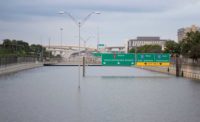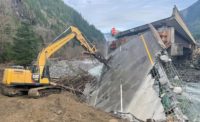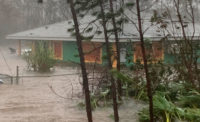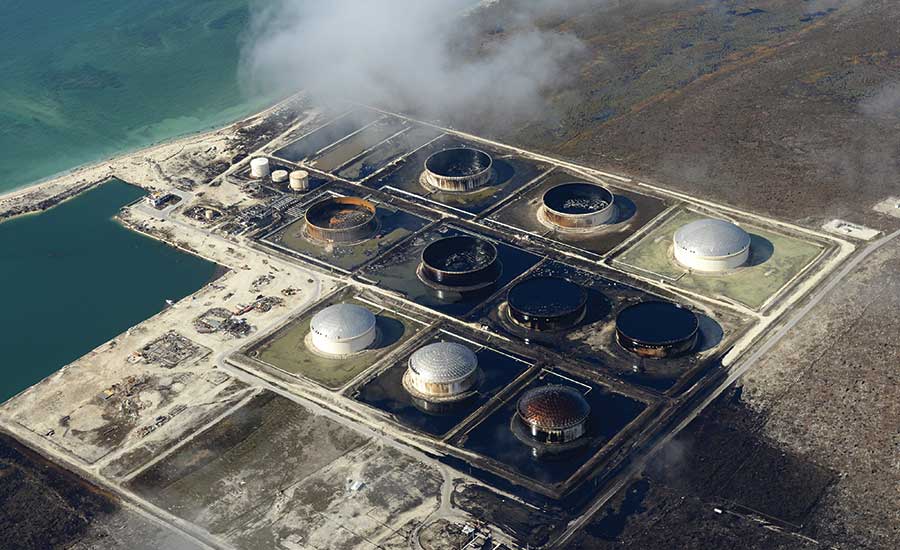Extreme Storms
Category 5 Hurricane Dorian Raises Alarm on Resilience

NC Highway 12 on Ocracoke Island is cut by overwash again as Hurricane Dorian moves away. Authorities say the village at the southern end of the island will probably be cut off until January and accessible only by ferry from the south until repairs are made.
PHOTO COURTESY OF NCDOT

Hurricane Dorian left industrial scale wreckage from Halifax, Nova Scotia, where the post-tropical remnants of the storm took out trees and fences and brought down a tower crane, to Grand Bahama Island, where it breached Equinor’s crude oil storage tanks and spewed their contents across the landscape. Equinor says cleanup is complex and doesn’t yet know the size of the spill.
PHOTO: JOHN MORRIS/REUTERS/NEWSCOM

Hurricane Dorian left industrial scale wreckage from Halifax, Nova Scotia, where the post-tropical remnants of the storm took out trees and fences and brought down a tower crane, to Grand Bahama Island, where it breached Equinor’s crude oil storage tanks and spewed their contents across the landscape. Equinor says cleanup is complex and doesn’t yet know the size of the spill.
PHOTO: JOE MARINO/UPI/NEWSCOM

A U.S. Coast Guard helicopter crew pulls away from Treasure Cay with a survivor.
U.S. COAST GUARD PHOTO BY SEAMAN ERIK VILLA RODRIGUEZ




As residents of the Bahamas’ northern islands grapple with death and destruction in the wake of Hurricane Dorian, engineers, scientists and government officials far and wide are addressing the dire need to better prepare for more intense and longer hurricanes.
“While infrastructure is traditionally designed to hold up to rare but expected extreme weather events, these events are no longer rare, and their durations and intensities are well beyond normal expectations,” says Cris Liban, Los Angeles-based LA Metro’s executive officer for environmental compliance and sustainability program management, and the chair of the American Society of Civil Engineers’ committee on sustainability. “I will never see a Katrina nor a Dorian here in L.A. What we will see, however, is the constant and consistent exposure of our infrastructure to a chronic state of extreme environment.”
Coincidentally, on Sept. 10 the Global Commission on Adaptation released a report urging all nations to advance climate adaptation solutions. The report finds that investing $1.8 trillion globally from 2020 to 2030 could yield $7.1 trillion in net benefits. More than half of the benefits total will come from more infrastructure adaptation, says the group.
“Coupled with the increasing hazards are the rapid increase in exposure due to population growth and the expansion of cities and industry that place more people and assets at risk, particularly along coastlines,” says the report. “For example, protecting against or accommodating sea-level rise in low-lying areas may no longer be possible—and coastal residents may need to systematically retreat.”
While Microsoft founder Bill Gates is its co-chair, the commission's 20-country membership does not include the U.S. The report also notes that national governments of its member countries "have not been asked to formally endorse" the report.
'Pretty Much Flattened'
Hurricane Dorian rapidly intensified from a Category 3 storm to a Category 5 with winds up to 186 mph in just days. It then stalled over the Abacos and Grand Bahama islands for three days as a Category 4 and 5 storm.
Reports say there are almost no structures left on the islands that aren’t badly damaged or destroyed.
“We have our building codes … but when you are talking in excess of 180 to 200 mph winds just sitting there, everything is pretty much flattened,” said Michael Pratt Sr., president of the Bahamas Contractors’ Association, reached by phone in Nassau. The storm was the strongest ever to hit the Bahamas.
After finally moving away from the islands, Dorian then swept the North Carolina coast, flooding out residents on Ocracoke Island and reshaping barrier islands before taking a turn north and causing massive power outages in Nova Scotia.
Dorian, the second most powerful hurricane ever recorded in the Atlantic Ocean, is just the latest monster storm to break records.
Research has shown that hurricanes such as Dorian, as well as Harvey in 2017 and Sandy in 2012, mark the beginning of a new stretch of unusual events—likely caused by climate change.
“The idea of predictability has pretty much gone by the wayside,” says Darcy Lenden Immerman, AECOM senior vice president of resilience.
To prepare, Immerman and others recommend a whole-systems approach that examines potential risks not only to infrastructure, but also to society as a whole—and for engineers to lead the way in developing it.
“Our short-sighted approaches cannot work, but change requires a level of leadership by structural engineers and getting back to the basics of assuring that communities exist in balance with the natural forces to which they are subjected,” says David O. Prevatt, an associate professor of engineering at the University of Florida’s Engineering School of Sustainable Infrastructure and Environment in Gainesville.
A Sept. 11 "preliminary virtual reconnaissance" report on the Bahamas and U.S. damage by the school's Structural Extreme Events group "provides a factual engineering perspective" that will be a precursor to on-site investigations group members will conduct once affected sites are accessible for "non-humanitarian missions," says Prevatt.
Click here to read the full report.
He says despite the loss of life in the Bahamas, "the successful performance of many structures likely saved many lives, such as the Marsh Harbour Healthcare Center, which served as a storm shelter and was functional immediately after the passage of the hurricane."
Prevatt notes the need for more study on impacts of slow-progression hurricanes on decision-making and the "reframing of disaster risk" for small island nations. While those issues are outside his group's purview, they are "nonetheless critical opportunities to learn from this disaster to inform research, policy and practice," he says.

Fatal Storm Stall
At least 76,000 people were impacted by Dorian when it hit the northern Bahamas' Abacos and Grand Bahama islands. While 50 deaths were officially reported as of Sept. 10, the count is expected to climb, with possibly 2,500 stlll missing.
Direct reports and communications from within the disaster zone have been spotty at best.
One group that has been able to get information is Yellow Dog Outfitters—a fly fishing guide service based in Bozeman, Mont., that has affiliated guides and lodges in the islands. It started filing updates to its website Sept. 3 that included the first of several damage assessment reports based on video footage from the Hope Town Sailing Club that were transmitted via the volunteer fire department, which noted that 30% of structures on Elbow Cay were demolished and 70% severely damaged. The reports were similarly grim from island to island.
The US Agency for International Development (USAID) says that satellite-based damage assessments have identified approximately 1,100 destroyed buildings and nearly 2,300 damaged buildings in Marsh Harbour on Greater Abaco.
In some localized areas of Marsh Harbour, satellite-based assessments indicate that up to 75% of buildings were destroyed, according to the NGO Map Action. Several nearby cays off the eastern coast of Abaco, including Elbow, Great Guana, Green Turtle and Scotland also experienced building destruction of between 25% and 75%.
With the storm passed, Peter McLeod, senior partner of Bahamas-based consultant DHP Associates, said his firm expects to be called in soon for damage estimates and assessments.
McLeod added he had seen one text message sent by an acquaintance from Hope Town, a small village near Marsh Harbour, who reported that his well-built, concrete-framed house now is uninhabitable—its windows blew out and roof came off.
About 90% of homes in the town, mostly older wood-framed structures, are either seriously compromised or knocked down, he reported.
The Public Hospitals Authority of the Bahamas advised residents of Grand Bahama, the Abacos and the surrounding cays to avoid drinking groundwater. Officials warn that groundwater on these islands could be contaminated with infectious bacteria, chemicals and other pollutants.
In a Sept. 4 insurance analysis, investment researchers from UBS Group AG estimate that insured damage in the Bahamas could total between $500 million and $1 billion.
For the storm overall, UBS projects that the total insured losses from Dorian could be between $5 billion and $10 billion, basing its estimate on a comparison with Hurricane Matthew, which followed a similar path in 2016. Insured losses from that storm were $4.5 billion.
Near Misses
Once it finally left the Bahamas, Dorian caused moderate panic and major preparations along the U.S. Atlantic coast.
Although transportation agencies and power utilities in southeastern states had mobilized in anticipation of a potential Category 5 hurricane, Dorian’s eye remained 60 to 100 miles off the shores of Florida, Georgia and South Carolina as it moved northward, sparing coastal areas and infrastructure inundated by Hurricane Florence’s massive rainfall last year.
Only moderate post-storm flooding was forecast for the Waccamaw River in northeast South Carolina; there were no bridge closures.
Public power utility Santee Cooper and state officials were monitoring a flood-breached former coal-ash storage pond at a decommissioned Conway, S.C., generating plant for potential environmental impacts, but there was no spill.
“We have building codes … but when you are talking in excess of 180 to 200 mph winds just sitting there, everything is pretty much flattened.”
– Michael Pratt Sr., president of the Bahamas Contractors Association
The storm’s gradual weakening to Category 2 occurred as it drew closer to North Carolina’s Outer Banks chain of low-lying barrier islands, placing them in the path of high-intensity winds around the eyewall that drove surges of 5 to 7 ft from both the Atlantic Ocean and Pamlico Sound, according to the state meteorologist.
While most of the Outer Banks is under National Park Service jurisdiction and uninhabited, the village of Ocracoke, located around a sheltered harbor at the southeast end of its 14-mile-long namesake island, was particularly hard hit.
Some of the 800 residents and property owners who remained in the village described in social media accounts of being temporarily trapped in their homes and attics by floodwaters.
To a large extent, they receded fairly quickly, allowing the National Guard and other agencies to begin funneling relief services by air and via the North Carolina Dept. of Transportation’s ferry service.
According to state emergency officials, the village’s water system has been restored, although under emergency power.
Further north on the island, Dorian’s storm surge cut a half-mile gap in State Route 12, the sole land route to NCDOT’s other ferry terminal, where the agency reports severe pavement damage. Protective dunes along the roadway were overwhelmed as well.
According to NCDOT spokesperson Tim Hass, the agency is currently scoping the details and limits of the repairs, which will likely be handled through an emergency contract. “We’re still developing a timeline,” he says.
While Dorian left the remainder of State Route 12 largely intact before crossing Cape Hatteras and moving offshore on the morning of Sept. 5, the prospect of recovering from yet another major tropical storm—and perhaps others in this year’s hurricane season—puts extra pressure on an NCDOT budget already stressed by past storm responses.
Rising costs and slow federal reimbursement for infrastructure restoration arising from recent federally declared emergencies have contributed to a budget shortfall and a deficit that forced the agency to furlough approximately 1,100 temporary and contract workers in August, and suspend work on hundreds of projects.
According to the agency, average annual storm response costs have risen to nearly $300 million during the fiscal year that ended June 30—from $66.7 million during fiscal years 2004-16.
Last week, NCDOT received $51 million from the Federal Highway Administration to reimburse costs incurred during many of its 2018 and 2019 storms.
Dorian response could cost the agency "north of $40 million, agency chief operating officer Bobby Lewis told local media on Sept. 9.
“As any reimbursement is welcomed from our federal partners, the frequency of weather events and their associated costs are more of a concern,” says NCDOT spokesperson Aaron Moody.
The shortfall also has had a ripple effect across the state’s construction industry.
James Smith Jr., executive director of the American Council of Engineering Companies of North Carolina, reports layoffs among several member firms that were released from NCDOT jobs.
“The effects have been devastating,” he says, adding that other states will have to take a closer look at how to prepare their project funding mechanisms for substantial disaster recovery costs. “Otherwise, they’ll be going through situations like this too.”
Not Ready
But the U.S. is largely unprepared for similar future storms.
“We in the U.S. are clearly vulnerable, perhaps not to the level of devastation experienced by the Bahamas, but certainly to the kind of damage delivered by Hurricanes Katrina and Rita on the Gulf Coast, Hurricane Sandy on the New York metropolitan area and Hurricane Harvey in Texas,” says William Wallace, president of consultant Wallace Futures and a recognized leader and author in sustainability engineering, who serves on several national and international professional society committees.
“Each incident provided proof that much of our infrastructure is woefully inadequate to handle storms of such intensity,” he says, adding that the worsening state of infrastructure, exemplified by ASCE’s latest D+ report card, “is not the sort of grade one wants to have earned with the real prospect of more intense storms.”
“The double threat of rising seas and greater storm surge alone could force hundreds of millions of people from their homes in coastal cities.”
– Global Commission on Adaptation
The Global Commission on Adaptation even called out the U.S. for not taking the potential threats to its coastal communities more seriously, pointing out that the highest rates of home construction since 2010 have occurred in flood prone areas.
“The double threat of rising seas and greater storm surge alone could force hundreds of millions of people from their homes in coastal cities, with a total cost to coastal urban areas of more than $1 trillion each year by midcentury,” its report says.
The report calls for revolutionary change in three areas—understanding, planning and finance—to ensure that climate impacts, risks and solutions are factored into decision making at all levels.
The commission, started by The Netherlands and whose members include Canada, Mexico, Germany, China and the UK, will announce on Sept. 24 the start of a year of action on adaptation.
Wallace says that with no action from Congress there’s little that can be done to improve infrastructure, and he is critical of the Trump administration for diverting infrastructure investments. Additionally, necessary changes to codes and standards are slow to come, he said.
Liban, of LA Metro, says a paradigm shift is necessary to rethink safety and the infrastructure that exists and needs to be built. \
His agency and the state of California are making headway. The Climate-Safe Infrastructure Working Group, of which LA Metro is a member, was able to provide a comprehensive approach to integrating scientific data concerning projected climate change impacts into state infrastructure engineering.
“The impacts of the hurricane season on infrastructure should help us think about our ability to survive as a species despite the increasing negative impacts of extreme weather events,” Liban says.
“But the cost of ignoring infrastructure investments is mounting. More importantly, we need to reassess how we continually value the benefits of a well maintained infrastructure and build the right project as much as we need to build the project right. While I see advances on many fronts, we need more engineers and our partners to step up and take a leadership role in advancing the new paradigm.”
By Pam Radtke Russell, Tom Sawyer, Jim Parsons and Debra K. Rubin











